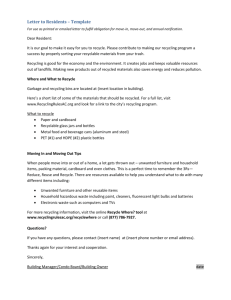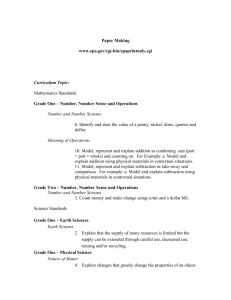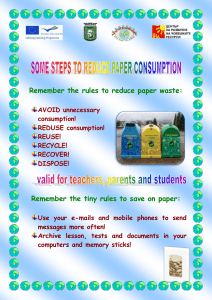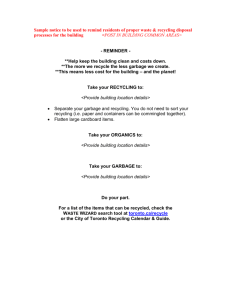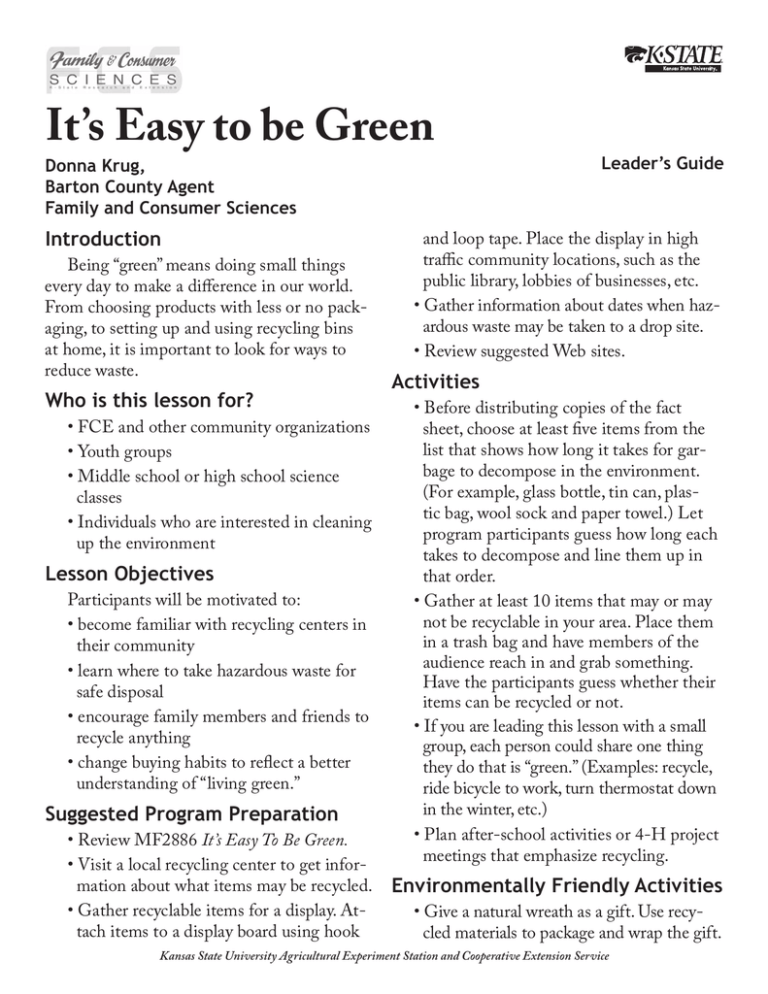
It’s Easy to be Green
Donna Krug,
Barton County Agent
Family and Consumer Sciences
Introduction
Being “green” means doing small things
every day to make a difference in our world.
From choosing products with less or no packaging, to setting up and using recycling bins
at home, it is important to look for ways to
reduce waste.
Who is this lesson for?
• FCE and other community organizations
• Youth groups
• Middle school or high school science
classes
• Individuals who are interested in cleaning
up the environment
Lesson Objectives
Participants will be motivated to:
• become familiar with recycling centers in
their community
• learn where to take hazardous waste for
safe disposal
• encourage family members and friends to
recycle anything
• change buying habits to reflect a better
understanding of “living green.”
Suggested Program Preparation
• Review MF2886 It’s Easy To Be Green.
• Visit a local recycling center to get information about what items may be recycled.
• Gather recyclable items for a display. Attach items to a display board using hook
Leader’s Guide
and loop tape. Place the display in high
traffic community locations, such as the
public library, lobbies of businesses, etc.
• Gather information about dates when hazardous waste may be taken to a drop site.
• Review suggested Web sites.
Activities
• Before distributing copies of the fact
sheet, choose at least five items from the
list that shows how long it takes for garbage to decompose in the environment.
(For example, glass bottle, tin can, plastic bag, wool sock and paper towel.) Let
program participants guess how long each
takes to decompose and line them up in
that order.
• Gather at least 10 items that may or may
not be recyclable in your area. Place them
in a trash bag and have members of the
audience reach in and grab something.
Have the participants guess whether their
items can be recycled or not.
• If you are leading this lesson with a small
group, each person could share one thing
they do that is “green.” (Examples: recycle,
ride bicycle to work, turn thermostat down
in the winter, etc.)
• Plan after-school activities or 4-H project
meetings that emphasize recycling.
Environmentally Friendly Activities
• Give a natural wreath as a gift. Use recycled materials to package and wrap the gift.
Kansas State University Agricultural Experiment Station and Cooperative Extension Service
• Choose or make gifts that are practical and consistent with environmentally
friendly materials. For example, assemble
the dry ingredients for cookies or soup in
a canning jar, attach a recipe and top it
with scraps of seasonal fabric, ribbon, and
a pine cone.
• Print your own gift wrap using nontoxic
paints on recycled craft paper.
• Use your newspaper’s comic section as a
cheery, bright and recyclable wrapping.
• Recycle old crayons by preheating the
oven to 250 degrees F. Put some crayons
in each cup of a muffin tin that has been
lined with a paper muffin cup. Mix the
colors to make multi-colored crayons. Be
careful not to overfill the cups. Children
should ask an adult helper to place the
baking tray in the oven. Turn on the oven
light, so you can watch the crayons melt.
Bake for 10 minutes or until all the crayons are melted. Remove baking tray from
oven and allow to cool. These make fun
little gifts for young children.
References and Web Sites for
Extended Learning
EHMI – Environmental Hazards Management Institute – daily recycler for home and office, 2002.
Municipal Solid Waste Generation, Recycling, and Disposal in the United States: Facts and Figures for 2007.
Environmental Protection Agency; available at
www.epa.gov/osw/nonhaz/municipal/msw99.htm#links
Sunflower First Step Recycling Center, Great Bend,
Kan.
http://www.epa.gov/safewater/kids
http://earth911.org/recycling
http://www.worldwatch.org
http://www.earthshare.org
More about plastic packaging symbols
http://www.kdheks.gov/kdsi/pg10_symbols_defined.html
http://www.thedailygreen.com/green-homes/latest/
recycling-symbols-plastics-460321
http://en.wikipedia.org/wiki/Resin_identification_code
Recycle symbols:
http://www.packaginggraphics.net/plastic-recycle-logos.htm
Reviewers
Berny Unruh, Barton County 4-H Youth
Development Agent
Mary Lou Odle, Saline County FCS Agent
Jan Stephens, K-State Research and Extension FNHS
specialist
Libby Curry, K-State Research and Extension FCS
specialist
Brand names appearing in this publication are for product identification purposes only. No endorsement is intended,
nor is criticism implied of similar products not mentioned.
Publications from Kansas State University are available on the World Wide Web at: www.ksre.ksu.edu
Publications are reviewed or revised annually by appropriate faculty to reflect current research and practice. Date shown is that of
publication or last revision. Contents of this publication may be freely reproduced for educational purposes.
All other rights reserved. In each case, credit
Donna Krug, It’s Easy to Be Green, Leader’s Guide, Kansas State University, August 2009.
Kansas State University Agricultural Experiment Station and Cooperative Extension Service
MF2885
August 2009
K-State Research and Extension is an equal opportunity provider and employer. Issued in furtherance of Cooperative Extension Work, Acts of May 8 and June 30, 1914, as
amended. Kansas State University, County Extension Councils, Extension Districts, and United States Department of Agriculture Cooperating, Fred A. Cholick, Director.



